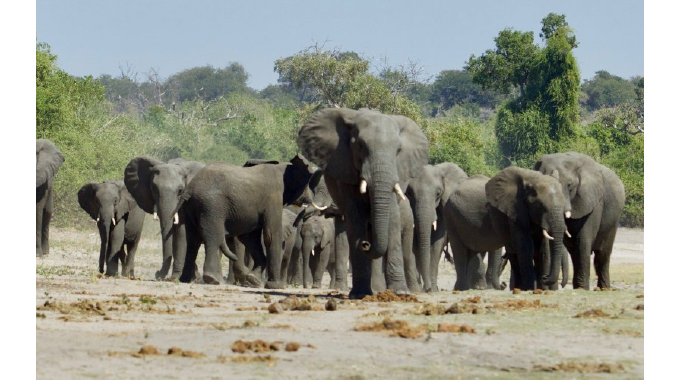
The Sunday News

Rutendo Nyeve, Sunday News Correspondent
The importance of water as a natural resource can never be understated as it underpins the foundation of life and plays the fundamental role in the sustenance of life systems that are vital for the survival of both humans and wildlife.
As the world recently commemorated the World Water Week, climate change, resilience and valuing water emerged as top of this year’s agenda. Held under the theme “Building resilience faster” most discourses surrounded climate resilience as well as Water and Sanitation Hygiene (WASH) during the global Water Week, and Sunday News reporter engaged on an investigation of how more than 45 000 population of elephants amongst other species have survived over the years in the drought-prone Hwange National Park (HNP).
When Hwange National Park was established in the 1920s, there were no perennial water sources within the park.
To protect the wildlife at the National Park, rangers established the system of diesel pumps throughout the park that created water sources during the dry season.
Today the HNP boasts of the largest elephant population in Zimbabwe and one of the largest in the region with over 45 000 individuals and other species like the lion, cheetah, buffalo and Zebra to mention but a few. Cognisant of the World Water Vision 2020 which states that half of the world’s wetlands were lost in the 20th century resulting in a major loss of biodiversity with many rivers and streams running through urban centres either dying or dead, at a closer look at how these animals survive becomes important.
The chronic and pernicious water crisis has shifted to be about water storage and ensuring availability in climate change induced-water-insecure times such as the ones we are living in. Issues of serious over pumping of key aquifers, major rivers running dry, and both surface and ground waters being subjected to increasing levels of pollution are on the rise.
These bring to light pertinent discussions that need to be held about the serious environmental impacts that are a consequence of the way water resources are managed and the need to ensure a water secure future where both humans and wildlife thrive in harmony and perpetuity.
This reporter caught up with International Fund for Animal Welfare (IFAW) which together with other key players that include Zimparks, WEZ, Imvelo Safaris, Bhejane Trust, Wilderness Safaris, African Bush among others have engaged in game water supply and conservation efforts.
IFAW Programs Officer, Global Landscape Conservation Programme Mr Nelson Mhlanga highlighted some of the efforts being undertaken to curb water challenges at HNP.
“As part of its Landscape Conservation Programme, the International Fund for Animal Welfare (IFAW) has been instrumental in supporting resilient water resource management and water conservation initiatives for wildlife in the iconic Hwange National Park (HNP) in Zimbabwe through enhancing rainwater harvesting and operational support.
Such techniques and institutional mechanisms are urgently needed to ensure water conservation and supply for wildlife populations that are a major tourist attraction and source of livelihood for the communities living proximal to the park. IFAW runs a Water Is Life project in collaboration with ZimParks that has seen the scooping of the heavily silted Nyamandlovu Pan, an exercise last undertaken 25 years ago,” said Mr Mhlanga.
Nyamandlovu pan is a unique game viewing point for many tourists that visit HNP. During the 2019 24 hour waterhole game count, a total of 14 different species were sighted at the pan including 1 133 elephants, 62 impalas, 24 zebras, 26 wild beasts, 15 spotted hyenas, and 1 lion.
“An estimated 11 880m3 of mud was removed from the watering hole, thereby enlarging its holding capacity. This exercise has been very beneficial to the thousands of elephants and other species that utilise the watering point, especially in the late hot dry seasons which have worsened over the years due to the effects of climate change,” said Mr Mhlanga.
What is of interest is how these efforts have not only made a positive impact on wildlife conservation in Hwange National Park but also to the lives of villagers bordering this paradise. Veteran Safari Guide Mr Mark Butcher who also led the Water for Hwange 2020 project spearheaded by Wildland Adventures spoke on the importance of an integrated approach in conservation.
“Personally I feel like if we have a concern with Africa’s wildlife, we have to involve Africa’s communities. It makes no sense to look after the animals without looking after the communities who live with these animals neither can we take care of the communities and forget about the animals,” said Mr Butcher.
The Water for Hwange 2020 project saw the replacement of the diesel pumped boreholes with solar hybrid pumped mechanisms. The project also saw villages bordering HNP like Ngunyana and Makheni villages being installed with water pumps.
These efforts to enhance rain water harvesting are key at a period where sub Saharan Africa is experiencing the effects of climate change which has been experienced across the region through prolonged droughts.
To most people, it still remains a miracle how a population of over 45 000 elephants amongst an array of other species survive in this paradise compared to other big parks in Africa like Tanzania’s Serengeti which has perennial rivers flowing.-@nyeve14



